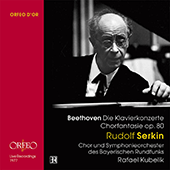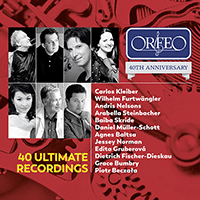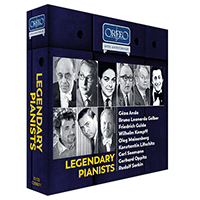Rudolf Serkin
Serkin’s father moved his family of eight children from Bohemia to Vienna in order that his talented son could gain a musical education. At the age of nine Serkin played for Alfred Grünfeld who suggested that young Rudolf should study with Richard Robert. Serkin made his Vienna debut at the age of twelve playing Mendelssohn’s Piano Concerto in G minor Op. 25, a work he would play throughout his career, but his father forbade any concert tours and saw that his son continued studying with Robert and also with Joseph Marx and Arnold Schoenberg for composition.
At the end of his period of study with Robert, Serkin played for Ferruccio Busoni, whose opinion was that Serkin was too old to study with him and should rather play as many concerts as possible. It was in this same year of 1920 that Serkin met violinist Adolf Busch. Although Serkin was only seventeen, Busch asked him to accompany his chamber group on tour and meanwhile invited Serkin to live with his family. From this time onward the lives of the two musicians were intertwined, Serkin living with the Busch family and eventually marrying Busch’s daughter Irene in 1935. During the 1920s Serkin played recitals both solo and in partnership with Busch, gave concerts with the Busch Chamber Players and at his Berlin debut played Bach’s Brandenburg Concerto No. 5. The duo was unusual for its time in that both players were equals on the concert platform, not a star violinist with his accompanist. In 1933 Serkin played for the first time in America at a concert in Washington with Busch, and by 1936 was prominent enough to make his Carnegie Hall debut with Arturo Toscanini. He played two works, Beethoven’s Piano Concerto No. 4 Op. 58 and K. 595 in B flat by Mozart.
In 1939 Serkin and the Busch family moved to America to escape the Nazis even though they had already been living in Basle, Switzerland. Not long after he arrived in America, Serkin was asked to join the staff of the Curtis Institute of Music where he taught until 1975. It was in 1949 that the germ of an idea took shape as the Marlboro Music Festival in Vermont. Busch was asked to organise a summer programme of chamber music at Marlboro College. In 1950 Busch got together a group of his musician friends: his cellist brother Hermann, Serkin, flautist Marcel Moyse, Moyse’s son Louis (a pianist), and his daughter-in-law Blanche (née Honegger), a violinist. Together they began an annual summer event of study groups and workshops for talented students. When Adolf Busch died in 1952, Serkin took over the helm until it was in turn passed to Richard Goode and Mitsuko Uchida in the 1990s. Serkin formed Marlboro into one of the world’s most prestigious music festivals where musicians gather to make chamber music together; there are no stars, but a community spirit where the experienced guest musicians coach the students.
Apart from his commitments at Curtis and Marlboro, Serkin continued to give many concerts throughout the world, touring Europe and North America every year. At his final Carnegie Hall recital in 1987 when he was eighty-four years old, Serkin played the last three sonatas by Beethoven.
Serkin practised incessantly at the piano, and at times gave the impression that in performance he and the piano were fighting a battle which he would ultimately win. A kind of gritty determination pervades his performances on record. Serkin’s son Peter Serkin said, ‘My dad hated to record. Absolutely hated it.’ All of Serkin’s earliest recordings were made with Busch for HMV and included works by Beethoven, Mozart, Schubert, Bach, Schumann, and Reger. The one solo work which Serkin recorded in 1936 was Beethoven’s ‘Appassionata’ Sonata Op. 57, a strong, dramatic, convincing performance showing Serkin’s affinity with the composer. One of the best of his chamber music recordings with Adolf and Hermann Busch is of Schubert’s Piano Trio No. 2 in E flat D. 929. Not only is it the finest recording of this work, it is one of the finest of chamber music recordings. During the 1930s and 1940s Serkin also recorded many of Brahms’s chamber works with the Busch Quartet. In 1938 Serkin made his first recording of a Mozart piano concerto, K. 449 in E flat, with the Busch Chamber Players, but it was not until the early 1950s that Serkin began to record for CBS; with George Szell and Alexander Schneider he recorded six of Mozart’s piano concertos. The 1950s also saw recordings of concertos by Schumann, Beethoven, Brahms, Reger, Prokofiev (No. 4, for left hand), and the Burleske by Richard Strauss. In 1960 Serkin made one of his most joyous of recordings: both piano concertos by Mendelssohn were recorded with Eugene Ormandy and the Columbia Symphony Orchestra. He had played the G minor Concerto at his Vienna debut, and he championed these works throughout his life.
Although identified in the public eye with Beethoven (his 1962 recording of the ‘Pathétique’, ‘Moonlight’ and ‘Appassionata’ Sonatas was a best-seller), Serkin had never performed the complete cycle of sonatas in public, nor recorded all thirty-two. In 1970, he programmed the complete series at eight recitals in Carnegie Hall. However, around eighteen of them were not in his repertoire, and the task of preparing them along with many other responsibilities including his recent appointment as director of the Curtis Institute proved too much, resulting in the cancellation of the remainder of the series. He did, however, record some of them for CBS at this time, but never recorded all of the sonatas.
During the 1980s Serkin recorded a selection of Mozart piano concertos with the London Symphony Orchestra and Claudio Abbado. In the same decade he recorded all the Beethoven concertos with the Boston Symphony Orchestra and Seiji Ozawa, as well as the last three piano sonatas. These were recorded live in Vienna in October 1987 when Serkin was eighty-four years old. These later recordings may have the weight of experience behind them, but even Serkin’s well-drilled fingers had slowed down by this time. Earlier recordings of these works exist, and it should be noted that Serkin recorded many concertos up to three times.
As well as attaining a successful life as a pianist and chamber musician, Serkin left a valuable legacy in the Marlboro Festival in Vermont and in his achievement, with Busch, of putting violinist and pianist on an equal standing in performance.
© Naxos Rights International Ltd. — Jonathan Summers (A–Z of Pianists, Naxos 8.558107–10)




















